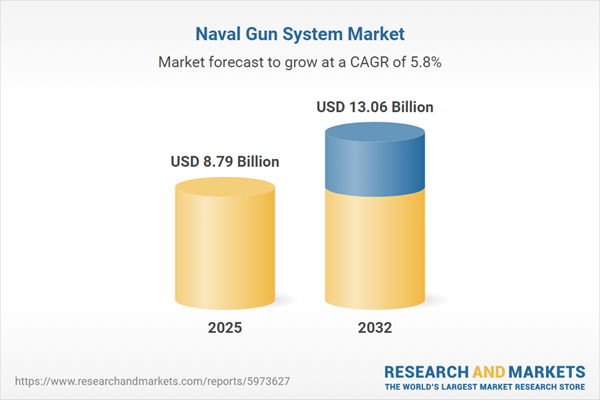Speak directly to the analyst to clarify any post sales queries you may have.
Naval gun systems are central to the ongoing transformation of maritime defense, driving new approaches in agility, interoperability, and rapid technological integration. Senior decision-makers need clear, actionable insights to guide procurement and modernization in an increasingly complex operational environment.
Market Snapshot: Global Naval Gun System Market Size and Growth
The global naval gun system market is positioned for significant expansion, with its value projected to grow from USD 8.31 billion in 2024 to USD 13.06 billion by 2032. Momentum is driven by sustained defense modernization programs and a continuing demand for advanced weapon systems capable of responding to evolving maritime threats. An anticipated value of USD 8.79 billion in 2025, alongside a compound annual growth rate of 5.81%, reflects the strategic emphasis on technological progress, fleet readiness, and streamlined procurement. Industry stakeholders are aligning future-focused solutions to deliver resilience and operational versatility across naval assets worldwide.
Scope & Segmentation: Naval Gun System Market Overview
This report provides high-resolution segmentation to enable executive alignment of technology investment with fleet strategy and modernization aims, across operational, technological, and geographic factors relevant to maritime defense leadership:
- Caliber: Large, medium, and small-caliber naval gun systems optimized for deterrence, air defense, and precision strike missions.
- Platform Types: Integration onto destroyers, frigates, corvettes, patrol craft, and amphibious assault vessels, supporting diverse mission sets and deployment from coastal to open-ocean operations.
- Technology Solutions: Automated, semi-automated, and manual fire control systems leveraging radar and electro-optical enhancements to improve target accuracy and response time.
- Mount Configurations: Single, twin, and multi-barrel setups, with electric, hydraulic, or manual actuation for adaptable performance and suitability for both retrofits and new builds.
- Rate of Fire: Systems designed for sustained and high-intensity engagement readiness, ensuring fleets can address both air and surface threats.
- End Users: Procurement models account for varying requirements of navies, marine corps, and coast guards, shaped by national strategies and allied commitments.
- Regional Focus: Market dynamics for the Americas, Europe, Middle East and Africa, and Asia-Pacific, reflecting region-specific procurement and defense collaboration imperatives.
- Industry Leaders: Company profiles include BAE Systems plc, Leonardo S.p.A., Thales Group, Rheinmetall AG, Hanwha Defense, MSI-Defence Systems Limited, China North Industries Group, JSC "KBP Instrument Design Bureau," Aselsan A.S., and Mitsubishi Heavy Industries, Ltd., supporting analysis of competitive landscape and partnership potential.
Key Takeaways: Strategic Insights for Naval Gun System Stakeholders
- Innovations in fire control technology are driving measurable improvements in targeting efficiency and overall mission success rates for navies globally.
- Adoption of modular and advanced material designs is reducing long-term maintenance needs and supporting scalable upgrades across ship classes.
- Strengthened connectivity with command networks contributes directly to more effective operational coordination during complex, multi-domain missions.
- Shifts to electric and hydraulic automation are simplifying system operations, reducing manual intervention, and enabling higher readiness across a variety of mission profiles.
- Flexible system architectures minimize transition time for new deployments and legacy fleet integration, optimizing modernization timelines.
- Custom supplier and procurement strategies are facilitating region-specific integration, enhancing ecosystem interoperability for national and allied clients.
Tariff Impact: United States Trade Policy and Supply Chain Adaptation
Recent changes in United States trade policy are leading to increased production costs for naval gun system manufacturers. In response, key industry players are reinforcing domestic supply chains and prioritizing local sourcing to boost resilience. This approach secures procurement schedules, supports ongoing modernization, and maintains capability development for U.S. and allied fleets.
Methodology & Data Sources
This report is built on comprehensive executive interviews, analysis of leading defense publications, and cross-validation against authoritative industry datasets. This ensures recommendations that support risk management and informed strategic planning for procurement decision-makers.
Why This Report Matters
- Equips procurement leaders to adapt acquisition and research strategies within the evolving naval gun system market landscape.
- Delivers actionable insights for maintaining operational readiness and shaping future capability development decisions.
- Enables comparative evaluation of suppliers and markets, supporting informed partnership and sourcing strategies.
Conclusion
The intelligence in this report enables executive teams to optimize technology investment, enhance fleet resilience, and align operations with emerging maritime security priorities, strengthening their position in the global market.
Additional Product Information:
- Purchase of this report includes 1 year online access with quarterly updates.
- This report can be updated on request. Please contact our Customer Experience team using the Ask a Question widget on our website.
Table of Contents
3. Executive Summary
4. Market Overview
7. Cumulative Impact of Artificial Intelligence 2025
Companies Mentioned
The companies profiled in this Naval Gun System market report include:- BAE Systems PLC
- Leonardo S.p.A.
- Thales Group
- Rheinmetall AG
- Hanwha Defense Co., Ltd.
- MSI-Defence Systems Limited
- China North Industries Group Corporation Limited
- JSC 'KBP Instrument Design Bureau'
- Aselsan A.S.
- Mitsubishi Heavy Industries, Ltd.
Table Information
| Report Attribute | Details |
|---|---|
| No. of Pages | 199 |
| Published | November 2025 |
| Forecast Period | 2025 - 2032 |
| Estimated Market Value ( USD | $ 8.79 Billion |
| Forecasted Market Value ( USD | $ 13.06 Billion |
| Compound Annual Growth Rate | 5.8% |
| Regions Covered | Global |
| No. of Companies Mentioned | 11 |









